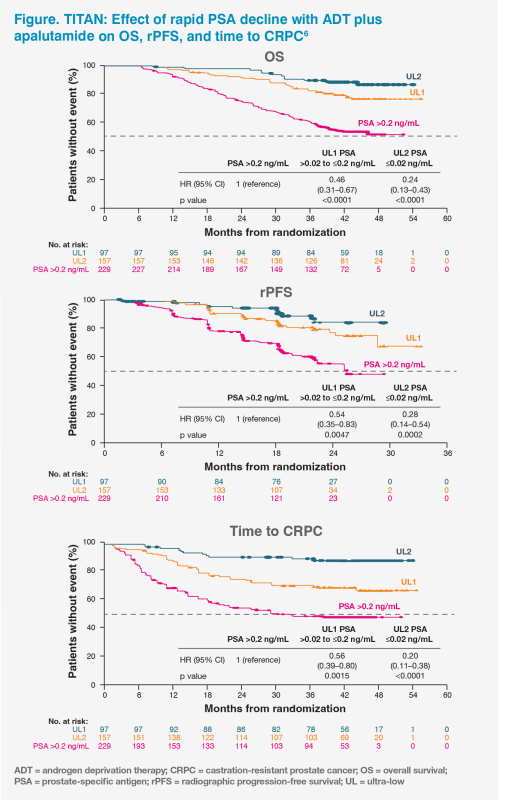Achieving deep PSA response and early management of skin rash in a mHSPC patient treated with ADT plus ARPI





Presentation, investigations and findings
A 72-year-old retired male construction worker, who was an ex-smoker and social drinker and had good past health, presented with lower urinary tract symptoms and back pain in December 2023. Subsequent testing revealed an elevated prostate-specific antigen (PSA) level of 19 ng/mL. A 12-core transrectal prostate biopsy carried out on 9 January 2024 showed tumour infiltration of >90 percent across all cores, with a Gleason score of 5+4, and perineural invasion.
A prostate-specific membrane antigen (PSMA) PET scan in the same month showed diffuse PSMA avidity involving whole prostate gland, with multiple bone lesions and maximum standardized uptake value (SUVmax) of 32. The disease was classified as high-volume, metastatic T3N1M1b de novo prostate cancer. The patient’s baseline Eastern Cooperative Oncology Group (ECOG) performance status (PS) was 1, as he was fully ambulatory, but was unable to carry out strenuous activity due to back pain.
The same PET scan also yielded an incidental finding of another cancer primary in the lung, for which the patient later received cardiothoracic surgery.
Treatment and response
After a discussion regarding available therapeutic options, the patient started androgen deprivation therapy (ADT) with 3-monthly injection of a luteinizing hormone–releasing hormone (LHRH) agonist and an oral androgen receptor pathway inhibitor (ARPI), apalutamide at the standard dose of 240 mg, on 25 January 2024. His PSA level immediately prior to commencing treatment was 16 ng/mL. The patient refused docetaxel in view of potential chemotherapy-related side effects.
One week after commencing treatment, a generalized itchy rash appeared on the patient’s trunk and all four limbs. Two weeks after onset, the patient presented to an accident and emergency department for treatment of the rash, which was classified as grade 1–2. He was given an antihistamine, chlorphenamine and fluocinolone acetonide steroid cream 0.025 percent BID.
As his response to rash treatment was not satisfactory, the patient presented to our cancer unit 9 days earlier than his planned follow-up appointment, on 17 February 2024. We switched his topical treatment to one of similar potency, but from another class of steroids, a glucocorticoid agent, mometasone furoate cream 0.1 percent. His rash completely resolved within 1 week of starting the new skin regimen. The patient was able to continue with the same dose and schedule of apalutamide throughout.
At his next follow-up, on 8 April 2024, the patient’s PSA level was undetectable at <0.1 ng/mL and has remained undetectable since. He also reported complete resolution of back pain. The patient remains fully ambulatory, with an ECOG PS of 0–1. He currently undergoes regular follow-up every 6 months and plans to continue the current regimen of ADT plus apalutamide indefinitely or until disease progression.
Discussion
The European Association of Urology (EAU) guidelines used at our centre stipulate that doublet therapy with ADT and abiraterone acetate plus prednisone or apalutamide or enzalutamide is to be offered to patients with M1 metastatic hormone-sensitive prostate cancer (mHSPC) who are fit for the regimen.1 They also recommend docetaxel in combination with ADT plus abiraterone or darolutamide to patients with M1 disease who are fit for docetaxel.1 Although our patient was fit and had high-volume disease, he did not wish to receive chemotherapy due to concerns that it may compromise his quality of life (QoL).
The addition of apalutamide to ADT was evaluated in the phase III, randomized, double-blind, placebo-controlled TITAN trial in patients with mHSPC (n=1,052; median age, 68 years). Apalutamide significantly improved overall survival (OS), reducing the risk of death by 48 percent after adjustment for crossover (adjusted hazard ratio [HR], 0.52; 95 percent confidence interval [CI], 0.42–0.64; p<0.0001), while the risk of radiographic progression or death was reduced by 52 percent (HR, 0.48; 95 percent CI, 0.39–0.60; p<0.001), vs ADT alone.2,3 At the same time, according to TITAN data, patients’ experience of pain and fatigue (intensity and interference) did not differ between the apalutamide and placebo groups for the duration of treatment.4
A post hoc analysis of patient-reported outcomes from TITAN showed that patients treated with apalutamide who, like our patient, achieved a rapid and deep PSA decline (≥90 percent decline or PSA ≤0.2 ng/mL) at 3 months had prolonged preservation of health-related QoL (as per total Functional Assessment of Cancer Therapy-Prostate [FACT-P]) and physical well-being, as well as less pain and fatigue compared with those who did not.5 Furthermore, rapid achievement of PSA decline to an ultra-low level (ie, >0.02–≤0.2 ng/mL within 3 months, like our patient’s) is associated with improved OS (HR, 0.46; 95 percent CI, 0.31–0.67; p<0.0001), radiographic progression-free survival (HR, 0.54; 95 percent CI, 0.35–0.83; p=0.0047), and time to castration resistance (HR, 0.51; 95 percent CI, 0.39–0.80; p=0.0015).6 (Figure)

Patients with a good baseline PS, such as the case described, tend to have higher expectations of treatment in terms of maintaining their energy levels. Apalutamide was recommended to our patient because in our experience, it is not closely associated with fatigue.7 However, rash is common with apalutamide, which the patient was informed about and was content with the trade-off.
Rash of any grade was the most common AE in the TITAN trial. The event rate for skin rash of any grade was 24.4 vs 8.3 per 100 patient-years of exposure and for grade 3–4 skin rash the event rate was 2.9 vs 0.6 per 100 patient-years of exposure with apalutatamide vs placebo, respectively.2 Although common, in our experience, most cases of rash tend to be of low grade and are relatively easy to manage with topical steroids of moderate potency and over-the-counter antihistamines.8 Rash may appear as early as the first week of treatment. Therefore, it is important to educate patients and ask them to report any symptoms as soon as possible for prompt management.
In conclusion, our patient’s case demonstrates that early initiation of ADT plus apalutamide leads to rapid reduction of PSA to undetectable levels, which has been associated with improved long-term outcomes, and that apalutamide treatment can be continued at full dose even in the presence of low-grade rash with appropriate and prompt management.